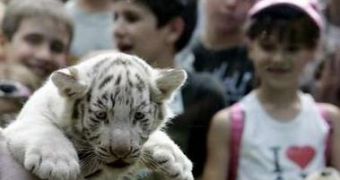We all know that the environmental collapse topic is overrated, old news and largely discussed, to the point where it has become devoid of its true meaning. However, with all the people talking about it and urging towards taking a stance, one would expect that all is going better and that the problems are finally straightened out. Unfortunately, it is far from being so. In fact, it's quite the opposite of that. We have only a couple of decades to do something before it is too late, and non-human life around us fades into oblivion. Forever.
There is a number of things that, although widely addressed of late, are going worse than expected, paving the way for nature's worst case scenario. Since probably most of you are unaware of the real facts and of the numbers behind them, let us brief you in as shortly as possible.
The direct extinction of mammals (like the white tiger cub in the picture), mostly due to their being pushed out of their habitats or hunted to the last individual, threatens today 1 every 4 mammals in the world. If you still think that's not too much, imagine that the very balance of nature (predator-prey) is affected. If only a few more species are exterminated, it is only a matter of time before all mammals will no longer stand a chance.
The dead zones of the oceans, areas that can support no life at all because they lack oxygen, are caused by pollution (sewage, nitrogen from farm fertilizers, industrial and vehicle emissions etc.), and aggravated by global warming. Such a zone can spread across from less than a square mile to more than 45,000 square miles (116,550 square kilometers). Since 1960, the number of these zones has been doubling every decade.
If nothing is done, ocean fish stock could go completely extinct by 2050, since a very large part of the population relies on fish as a stable part of their diet, leading to massive amounts of fish being constantly captured. About a third of the fished species, also threatened by pollution, has been reduced to only 10% of the initial populations, so now it's only a matter of time before complete extinction. The fish species are also interconnected, so affecting some will also have a major impact on others.
Although the damage done to the rain forest has been under discussion for decades, it is still critically present in Amazonian areas. Deforestation, logging, global warming, lack of rain, agriculture, livestock, drought and fires will ultimately obliterate the rain forest by 2030, together with all its wildlife. Every percent destroyed eventually impacts the remaining forest in a destructive way, by increasing the strength of the negative factors (less forest means less rain, which, in turn, translates into even less forest, in a perpetual cycle, until there's nothing left to form a cycle). Losing rainforests accelerates global warming and determines less rainfall in places situated very far away, like India.
The Arctic ice is melting at unprecedented rates, causing the wildlife it sustains to resort to unnatural habits, and ultimately be exterminated. Also, it causes ocean levels to rise just enough to do a little bit more damage.
Carbon dioxide emission is the runner-up in the top of the most dreadful environmental issues and, also, the main human-related factor responsible for global warming. If nothing is done soon about its sources (vehicles, industry or agriculture), by the end of the century, our planet will be inhabitable, even if CO2 levels don't rise anymore (but they will). Average temperatures will rise with about 7°C (12°F), although a bit more than half of this is enough to cause a disastrous domino effect of weather extremes, with all their negative outcomes. We are just one step before being too late, so switching to clean technologies is a must, as soon as possible.
Nevertheless, the very top factor of this black list is held by overpopulation. Basically, the last 50 or so years recorded a population expansion larger than all the 4 million years of human history before them. For a more accurate image, think that by early 19th century we had barely managed to hit one billion, while in the last 200 years since then, we've changed that figure to 6.5 billion. Moreover, we're still counting and expanding in a geometrical proportion, with about 74 million people added each year, all of which are in need of large amounts of food, space and water.
People are those who influence every other previously described negative environmental factor. They pollute the planet and exterminate world's animals, fish and forests. What can be done about it? While this article hardly provided new information, except, maybe, for a few numbers, it will certainly not help change the world for the better just like that. It could, however, give you something to ponder over, at least for a few hours.

 14 DAY TRIAL //
14 DAY TRIAL //